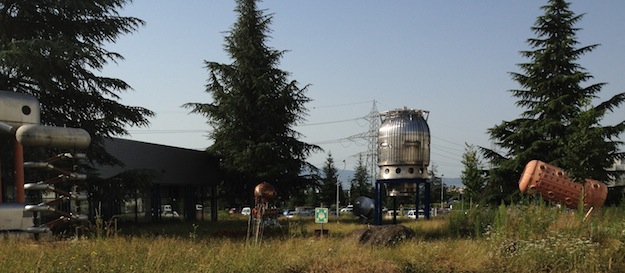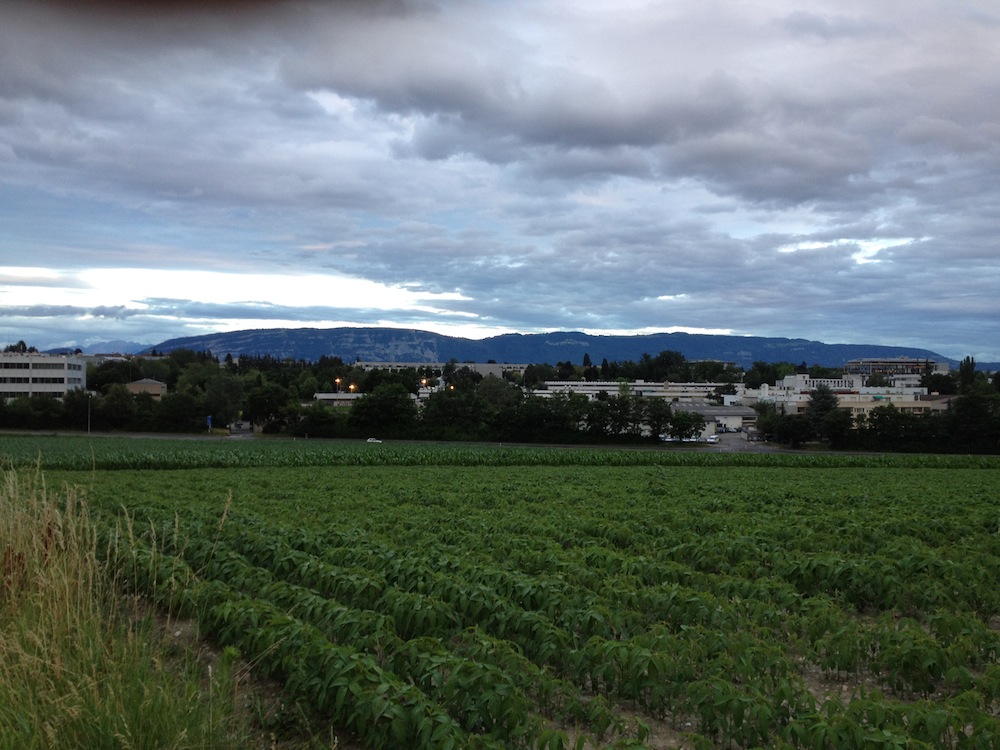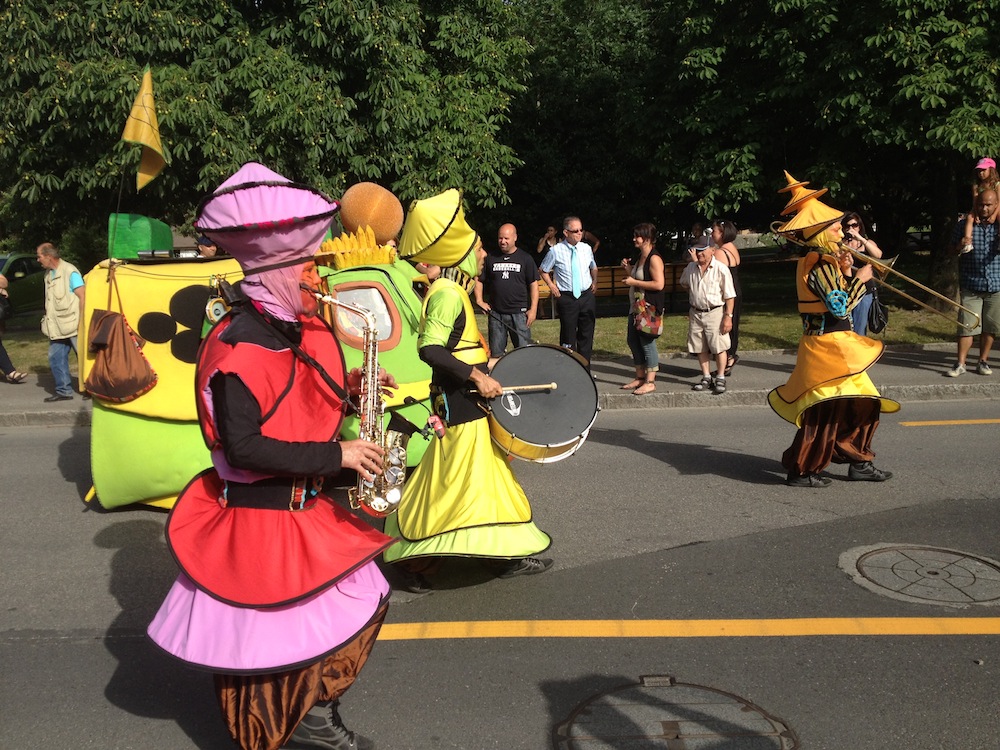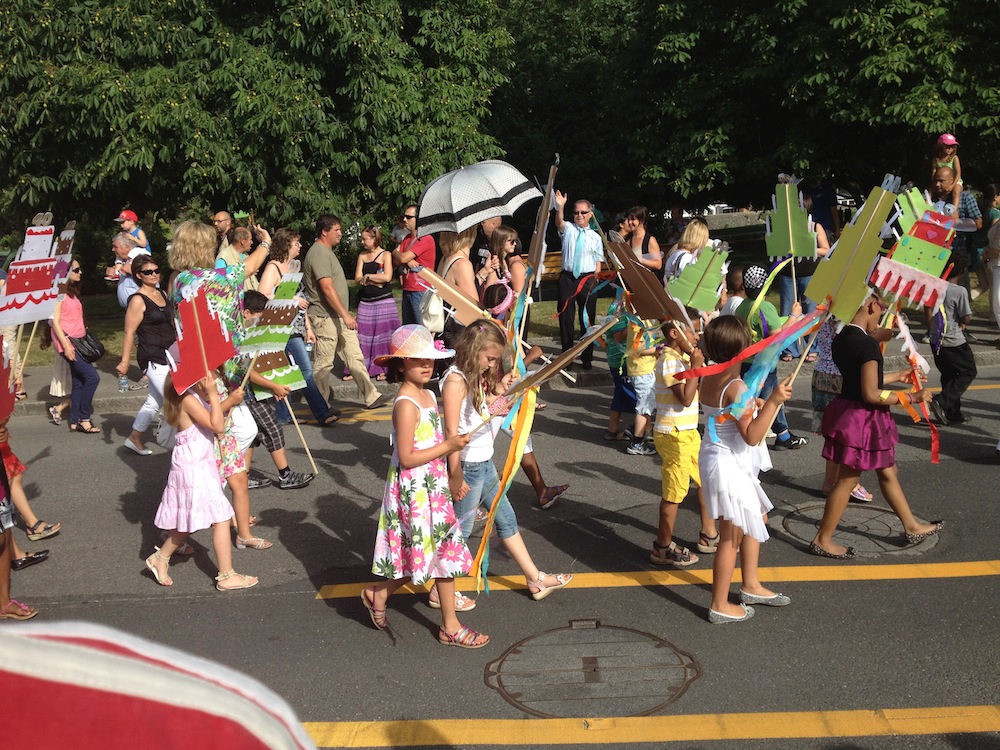When people think of CERN they generally think of the Large Hadron Collider and the Higgs particle and maybe black holes or even the Illuminati. But for the people who work there, CERN is also a place.
I think the best way to describe CERN and the nearest town, Meyrin, is “ugly buildings in a beautiful landscape.” That isn’t entirely fair. Many of the CERN buildings are utilitarian rather than elegant, and they have been refurbishing them over the years. Meyrin is an outcrop of horrible concrete apartment blocks that look like they were all built at once during the architectural nadir of the 1960s and haven’t aged well. But if you look out a window at CERN, or if you cross the main drag into the old part of Meyrin, you’re suddenly in a picture postcard. And life there has a special quality all its own.
So here are some pictures my husband took of CERN and Meyrin on his most recent trip, in June.
The big silver thing in this photo, and in the photo up top, may look like an alien spaceship (or a giant vacuum tube, to those of a certain age), but it’s actually the Big European Bubble Chamber, or BEBC. If you hit that link, you’ll see a photo of scientists working on it, which will give you an idea of its scale. The orange cylinder on the side is the Gargamelle detector.
The Globe of Science and Innovation is relatively new—it was designed by architect Peter Zumthor for the Swiss Pavilion at the World Exhibition in Hanover in 2000, and it was relocated to CERN in 2004. It is used for events and discussions, and it houses temporary exhibits as well. My husband tells me it’s the world’s largest wooden structure.
My husband stayed in Meyrin on his last trip, and this was the view on his walk to work. That’s Meyrin in the distance, and beyond it is Saleve, Geneva’s local mountain.
This next group of pictures is of the traditional end-of-school parade in Meyrin. Meyrin may have terrible architecture, but it’s a great place to live. It’s the most international city in the world, home to people from 110 different countries. Most of them are temporary residents, spending a year or two at CERN, the UN, the World Council of Churches, or one of the many other international organizations in the area. It’s so close to the airport that the roar of the planes sometimes forces all conversations to cease—but that’s also a constant reminder that none of us is there to stay. And the city itself seems almost deliberately designed to help newcomers make connections easily. It has a central shopping area (OK, it’s a mall) that hosts exhibits and a weekly market, several schools, and little pocket playgrounds where moms can chat while the kids play in a safely enclosed area. Even though the population is transient, it’s easy to meet people and to quickly integrate into the community. I made some good friends during my six months there.
The first time I saw the parade, I was taken completely by surprise. I was sitting on my balcony on an ordinary day, and suddenly the street was filled with children and music and dignitaries—the mayor and all the city government turn out for the parade. Each class has a theme, and the children carry signs, as they do here, or wear funny hats. The following year, when we lived in France, my children participated in a similar event at their schools at Christmastime. The mayor wasn’t in the parade, but we went to City Hall, where the children were given juice in real wineglasses and the adults were served wine in plastic cups.
After the parade, there is a carnival, with rides and junk food. It seems like a great way to end the school year, and I’m fascinated by what a big deal this is—it seems like a much bigger event than the last day of school here in the U.S.
At CERN and Meyrin, the exotic and the everyday coexist side by side. One of the regulars at a playground I frequented was a man who had been a pilot in the Ethiopian air force; now he was taking care of his two children while his wife was posted at the UN. We were walking back one day at lunchtime when a woman in a bright red and green wrap stopped us to ask if she was waiting for the right bus. We assured her she was, and as we walked away, my friend said, “I could have answered her in Somali—I spent 11 years in one of their prisons.” Her clothing and accent had clued him in to her nationality, but he wasn’t in Somalia any more, he was in Meyrin, a place where differences get washed away by the things we have in common, both the work that brought us there and the experience of being a stranger in a foreign land.









